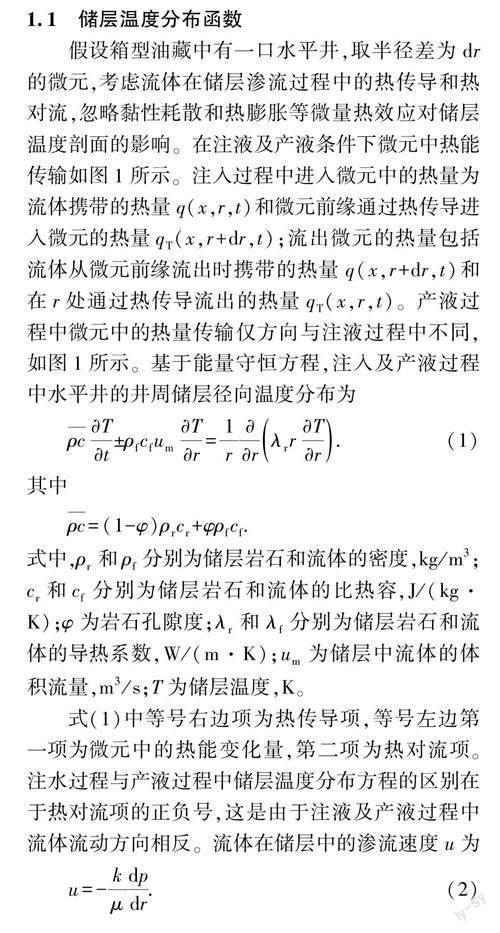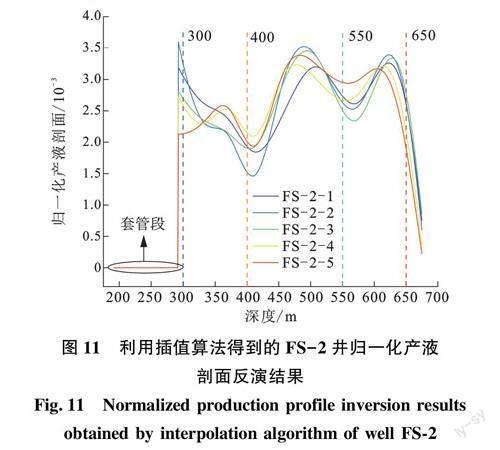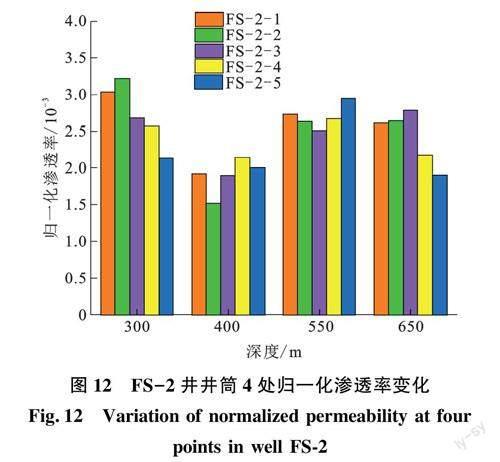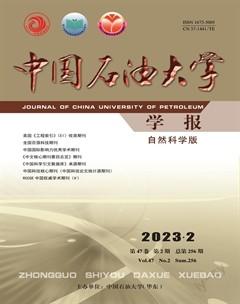基于Adam优化算法的水平井流动剖面测温反演方法
朱海涛 林伯韬 石兰香 窦升军



摘要:為提高油藏注水开发效率,制定精细的分层配产配注制度,须针对水平井开展吸水及产液剖面的高效检测。对此,提出基于自适应矩估计优化算法(Adam算法)的水平井吸水及产液剖面测温反演方法。该方法首先利用储层与井筒内的温度分布模型构建反演目标函数,其次通过Adam优化算法,在最优化反演目标函数的过程中定量获取流动剖面。将该方法应用于阿曼Safah油田及新疆风城油田的两口水平井,采用生产测井工具测得各井段吸水量和井口测量的产液量对反演结果进行验证。结果表明:建立的反演方法不需要求解复杂的耦合模型,计算效率高,不仅可以定量监测流动剖面的动态变化、评价各层段的贡献率,还可半定量刻画水平井各层段相对渗透率的演化规律,指导现场制定更加精细化的配产、配注及增产方案。
关键词:吸水剖面; 产液剖面; 分层配产配注; 温度反演; Adam优化算法
中图分类号:TE 357 文献标志码:A
引用格式:朱海涛,林伯韬,石兰香,等.基于Adam优化算法的水平井流动剖面测温反演方法[J].中国石油大学学报(自然科学版),2023,47(2):99-107.
ZHU Haitao, LIN Botao, SHI Lanxiang, et al. An inversion method to calculate horizontal well flow profile using temperature data based on Adam optimization algorithm[J].Journal of China University of Petroleum(Edition of Natural Science),2023,47(2):99-107.
An inversion method to calculate horizontal well flow profile using temperature data based on Adam optimization algorithm
ZHU Haitao1, LIN Botao1, SHI Lanxiang2, DOU Shengjun3
(1.College of Artificial Intelligence, China University of Petroleum(Beijing), Beijing 102249, China; 2.Research Institute of Petroleum Exploration & Development, PetroChina, Beijing 100083, China;3.Xinjiang Huishi Petroleum Technology Company Limited, Karamay 834000, China)
Abstract: In order to improve the efficiency of water injection and design a finely stratified production and injection workflow, an efficient detection of the injection and production flow profile along a horizontal well is required. In this regard, a method based on the adaptive moment estimation optimization (Adam) algorithm was proposed to inverse the injection and production profile in a horizontal well using the temperature data. First, a temperature distribution model in both the reservoir and wellbore was applied to construct an inversion target function. Secondly, the Adam optimization algorithm was used to quantitatively obtain the fluid flow profile from solving the optimization target function. The method was used to analyze the flow profile of two horizontal wells in Safah Oilfield (Oman) and Fengcheng Oilfield (Xinjiang, China), respectively. The inversion results were verified against the sectional injectivity measured by production logging down hole and the total production measured on the surface. The results show that the inversion method has high computational efficiency without solving complex coupling models. It is not only capable of quantitatively monitoring the dynamic evolution of the flow profile and evaluating the contribution rate of each layer section, but also provides a semi-quantitative portrayal of the evolution law for the relative permeability in each section of horizontal wells, guiding the field engineers to design a more finely production and injection workflow, and stimulation schemes.
Keywords: injectivity profile; production profile; stratified production and injection; inversion of temperature data; Adam optimization algorithm
注水井的吸水剖面和生产井的产液剖面资料是进行油田开发动态分析必不可少的依据[1-3]。目前,水平井中吸水和产液剖面的监测主要通过生产测井工具(PLT)实现。传统的PLT在水平井中应用时存在输送困难、容易卡井、成本高且不能胜任长期监测任务的问题[4-6]。相较于PLT作业,水平井筒中的温度测量相对简便快捷。例如分布式光纤温度传感系统(DTS)可灵活安装在套管内外,提供高精度的井筒温度数据[7]。利用油藏和井筒之间的传热传质规律,国内外一些学者建立了相关的理论分析模型,将温度数据解释为相应的流动剖面。Hashish等[4,8-9]提出了基于传热模型解析解曲线图版的吸水剖面反演方法。Pimenov等[10]介绍了基于最小二乘算法的水平井吸水剖面温度反演方法。
Zhang等[11]、Yoshioka等[12-14]、Sui等[15]、朱世琰[16]、蔡珺君等[17-18]建立了基于莱温伯格-马夸特算法(L-M算法)的水平井产液剖面温度反演方法。Li等[19-20]、Luo等[21-27]分别建立了基于L-M算法、马尔可夫链蒙特卡罗算法(MCMC 算法)以及模拟退火算法(SA算法)的水平井产出剖面温度反演方法。然而,上述的研究多是单独针对吸水或产液剖面的反演方法,对流动剖面通用性反演方法的探讨较为欠缺,且相关的反演方法需要求解复杂的耦合模型;当反演模型复杂、参数较多时,迭代次数显著增加,反演效率低,模型收敛慢,容易出现不收敛的情况。为了能长期实时监测水平井的流动剖面,笔者提出基于可自动调节步长的自适应矩估计优化算法(Adam算法)建立水平井流动剖面测温反演方法,并将此方法应用于油田现场,利用现场测量数据对反演结果进行验证,并分析水平井注入及生产过程中的流动剖面及各层段相对渗透率的演变过程。
1 流动剖面反演方法
基于能量守恒定律,首先建立水平井非等温流体注入及产出过程中瞬态温度分布函数,其中包括储层温度分布函数和井筒温度分布函数。反演方法主要包括反演目标函数的构建和反演目标函数的最优化。反演目标函数表示为储层温度分布函数与井筒温度分布函数在井壁附近的误差函数。鉴于Adam算法具有自适应调节步长(学习率)和参数更新效率高的优点,采用该算法作为反演目标函数的优化算法。将反演目标函数作为Adam优化算法中的目标函数,流动剖面作为反演目标参数,在目标函数最优化过程中,定量确定反演目标参数(流动剖面)。
1.1 储层温度分布函数
假设箱型油藏中有一口水平井,取半径差为dr的微元,考虑流体在储层渗流过程中的热传导和热对流,忽略黏性耗散和热膨胀等微量热效应对储层温度剖面的影响。在注液及产液条件下微元中热能传输如图1所示。注入过程中进入微元中的热量为流体携带的热量q(x,r,t)和微元前缘通过热传导进入微元的热量qT(x,r+dr,t);流出微元的热量包括流体从微元前缘流出时携带的热量q(x,r+dr,t)和在r处通过热传导流出的热量qT(x,r,t)。产液过程中微元中的热量传输仅方向与注液过程中不同,如图1所示。基于能量守恒方程,注入及产液过程中水平井的井周储层径向温度分布为
中,ρr和ρf分别为储层岩石和流体的密度,kg/m3;cr和cf分别为储层岩石和流体的比热容,J/(kg·K);φ为岩石孔隙度;λr和λf分别为储层岩石和流体的导热系数,W/(m·K);um为储层中流体的体积流量,m3/s;T为储层温度,K。
式(1)中等号右边项为热传导项,等号左边第一项为微元中的热能变化量,第二项为热对流项。注水过程与产液过程中储层温度分布方程的区别在于热对流项的正负号,这是由于注液及产液过程中流体流动方向相反。流体在储层中的渗流速度u为
(3)通过Adam算法优化反演目标函数。将注液和产液工况下的反演目标函数(式(18)和(19))分别作为Adam算法的目标函数,对其进行优化,使反演目标函数满足约束条件。具体的反演流程如图4所示。其中初始參数包括步长(学习率)α,指数衰减率β1和β2;k为时间步长,初始值为0;f(k)为目标函数在时间步长k处的梯度;m(k)、v(k)分别为在时间步长k处的偏一阶矩估计和偏二阶矩估计;(k)、(k)分别为在时间步长k处的修正偏一阶矩估计和修正偏二阶矩估计;误差限e=10-10。
(4)当Adam算法优化完毕时判断S(g)<ε是否成立。若成立则g*=g(k+1),即为所求的各离散区间内的流动剖面;若不成立,则调整参数,继续使用Adam算法计算,直至S(g)<ε成立。
3 现场应用
3.1 实例井概况
实例井1为位于阿曼Safah油田的某口水平注水试验井FS-1,垂深1 420 m,水平段长118 m,其中包括水平段开始处的一个长度为28 m的非渗透段(套管段)。注入流体为水,注入时间为4 h,井径为177.8 mm,注入流量为150 m3/d。采用热电偶测量水平井筒中不同位置的温度。水平段开始时的进口流体温度为40 ℃,原始地层温度为70 ℃。其中FS-1井的地层导热系数为3 W/(m·K);地层比热容为1 000 J/(kg·K);地层密度为2 600 kg/m3;注入液的比热容为4 127 J/(kg·K);注入液的导热系数0.67 W/(m·K);地层初始压力为10.5 MPa。热电偶测得水平段各点的温度数据如图5所示[10]。其中温度梯度较大的两个位置分别处于套管非渗透段和井筒末端。
实例井2是位于新疆风城油田重32区某SAGD井组中的产液井FS-2,垂深200 m,水平段长413 m。此SAGD井组于2009年投产,蒸汽腔发育稳定。在生产过程中注汽井恒压注入热蒸汽,对产液井来说蒸汽腔可近似看作稳态边界。FS-2井的井身结构及温度测量位置如图6所示,现场采用热电偶测量水平井筒中离散点的温度。FS-2井的原始地层温度为18 ℃,其上方蒸汽腔中的温度约为233 ℃。FS-2井的地层导热系数为3.15 W/(m·K);地层比热容为890 J/(kg·K);地层密度为2 600 kg/m3;产出液的比热容为3 200 J/(kg·K);井径为177.8 mm;地层初始压力为5.8 MPa。现场分别测量了FS-2井在5个不同时间点(间隔30 d)的温度数据,即从测温开始第30、60、90、120和150 d的数据,分为FS-2-1~FS-2-5共5组数据,如图7所示。
3.2 吸水剖面反演
将FS-1井的相关参数及温度测量数据代入反演目标函数(式(18)),按照流程进行反演,其中反演误差ε设置为10-4。当反演误差函数满足预设精度后,FS-1井的吸水剖面反演结果与生产测井工具(PLT)测量结果的对比如图8所示。其中0~28 m井段为不渗透段(套管段),吸水量为0。图8表明53~93 m井段为相对高渗透井段,吸水量最高,其他井段的吸水量相差较小。从图8中可见,各井段吸水量的反演值与测量值高度吻合,平均相对误差约为13%。其中40.5~53,73~93,93~105.5 m井段吸水量的反演值与测量值的相对误差小于2%,证实了利用此方法反演水平井吸水剖面的可靠性。井筒末端105.5~118 m井段的反演结果误差较大,这可能是井筒末端储层中存在的“横流”造成的。流体注入到储层中后,在储层中发生横向流动,影响了储层与井筒之间的热量传递,最终导致反演与PLT测量的结果存在一定差距。
注入剖面的反演结果可以反映各井段注入量的相对贡献率,指导现场工程师制定更加精细化的注液方案,并且可根据各层段相对注入量的变化,动态调整注液方案,防止发生指进,以达到最优的注入效果。从图8中可以看出,53~93 m井段的相对吸水量达到了54%,相对渗透率较高,而其他井段的相对吸水量不超过15%,在注液过程中发生了一定程度的指进现象。此时,需要快速制定相应的调剖方案,以实现最佳注液效果。
3.3 产液剖面反演
将FS-2井的相关参数及温度测量数据代入到反演目标函数(式(19))中进行反演计算,其中反演误差ε设置为10-4。当反演误差函数满足预设精度后,FS-2井的产液剖面反演结果如图9所示。其中,191~292 m井段为套管段,产液量为0。反演结果中452~572 m井段为对产量贡献率最高的层段,332~412 m井段次之,而远离水平井跟部的632~675 m井段的贡献率接近为0;这与井筒测量温度的变化趋势基本一致。这说明此SAGD产液井井筒中的温度主要由储层液体携带至井筒的热量决定。反演过程中获得的反演温度和热电偶测量的井筒温度对比如图10所示。从图10中可以看出,反演温度和测量温度吻合度较高,平均绝对误差小于0.2 ℃,证实了反演过程的准确性。
利用FS-2井口测量的总产量验证反演结果,FS-2-1、FS-2-2、FS-2-3、FS-2-4、FS-2-5组总产液量的测量值分别为87、85、70、103、121 m3,对应的反演值分别为86.99、85.01、69.98、120、109.91 m3。总产液量的反演值与测量值吻合度较高,平均相对误差为5.13%。其中FS-2-1组、FS-2-2组以及FS-2-3组的相对误差小于0.1%,证明该方法可靠。对比FS-2井各时间段的产液量(图9),若在注采施工参数不变的情况下,此结果可定性评价FS-2井各井段渗透率的动态变化,并用以诊断井筒中可能发生储层伤害的井段,为制定增产方案提供依据。
热电偶测温的缺点在于测温点的间距较大,无法捕捉更为精细的温度剖面数据,使反演的流动剖面精细化程度较低。采用三次插值算法拟合FS-2井热电偶测温结果并反演流动剖面。为方便比较,将总产液量设为1,得到沿井筒连续分布的归一化产液剖面,如图11所示。从横坐标向上引垂线,即可得到井筒中任一点产液剖面随时间的变化。假设产液过程中流体流动符合达西渗流规律,在注采条件不变时,渗透率与产液量成正比。可利用归一化产液剖面半定量分析渗透率变化。利用达西滲流公式和产液剖面分别求得井筒中300、400、550与650 m处的归一化渗透率,如图12所示。300和650 m处的渗透率随时间呈下降趋势,由此可判断这两处地层有发生储层伤害的趋势,应及时制定相应的治理措施。
反演结果精度及连续性取决于温度测量结果的精度及连续性。随着温度探测器的快速发展,未来可获取时间间隔更短、分辨率更高的井筒温度数据(如DTS光纤测温所得数据),可利用本方法对地层流动剖面及渗透率开展更精细的分析,为现场提供精细化的配产配注方案。
4 结 论
(1)建立的反演方法不需要求解复杂的耦合模型,计算效率高;不仅可以定量监测流动剖面的动态变化,评价各层段的贡献率,还可半定量刻画水平井各层段相对渗透率的演化规律,指导现场制定更加精细化的配产、配注及增产方案。
(2)Adam优化算法同时利用了梯度的一阶矩估计和二阶矩估计,自适应调整反演参数的步长,具有较高的初速度。可高效反演水平井流动剖面。
(3)阿曼Safah油田和新疆风城油田的两口水平井的流动剖面反演结果与现场测量数据之间吻合度较高。其中吸水剖面反演结果与PLT测量结果之间的平均相对误差为13%,产液剖面反演的日产液量与实测值的平均相对误差为5.13%,证实此方法可靠。
参考文献:
[1]侯连华,王京红,信荃麟,等.吸水剖面测井资料在油田开发中的应用[J].石油大学学报(自然科学版),1997,21(2):20-22,26,116.
HOU Lianhua, WANG Jinghong, XIN Quanlin, et al. Application of water absorption profile logging data in oilfield development[J]Journal of the University of Petroleum,China(Edition of Natural Science),1997,21(2):20-22,26,116.
[2]隋義勇,李治平,王继强,等.用隐式非线性方法预测注水井吸水剖面[J].中国石油大学学报(自然科学版),2010,34(6):95-98.
SUI Yiyong, LI Zhiping, WANG Jiqiang, et al. Prediction of water injection profile using implicit nonlinear method[J]. Journal of China University of Petroleum (Edition of Natural Science), 2010,34(6):95-98.
[3]王海静,薛世峰,高存法,等.非均质油藏水平井射孔调剖方法[J].中国石油大学学报(自然科学版),2012,36(3):135-139,150.
WANG Haijing, XUE Shifeng, GAO Cunfa, et al. Profile control method for perforated horizontal wells in heterogeneous reservoirs[J]. Journal of China University of Petroleum (Edition of Natural Science), 2012,36(3):135-139,150.
[4]HASHISH R G, ZEIDOUNI M. Injection profiling in horizontal wells using temperature warmback analysis[J]. Computational Geosciences, 2021,25(1):215-232.
[5]OUYANG L B. Production and injection profiling-challenges and new opportunities[R]. SPWLA-2005-MM, 2005.
[6]KAESHKOV I S, KREMENETSKIY M I, BUYANOV A V. Horizontal well monitoring based on temperature profile measuring with distributed temperature sensors (DST)[R]. SPE 171236-MS, 2014.
[7]OUYANG L B, BELANGER D L. Flow profiling by distributed temperature sensor (DTS) system-expectation and reality[J]. SPE Production & Operations, 2006,21(2):269-281.
[8]HASHISH R G, ZEIDOUNI M. Analytical approach for injection profiling through warm-back analysis in multilayer reservoirs[J]. Journal of Petroleum Science and Engineering, 2019,182:106274.
[9]HASHISH R G, ZEIDOUNI M. Warmback analysis to determine fracture geometry of a single-stage hydraulic fracturing stimulation[J]. International Journal of Thermal Sciences, 2020,155:106423.
[10]PIMENOV V, BROWN G A, TERTYCHNYI V V, et al. Injectivity profiling in horizontal wells via distributed temperature monitoring[R]. SPE 97023-MS, 2005.
[11]ZHANG S, ZHU D. Efficient flow rate profiling for multiphase flow in horizontal wells using downhole temperature measurement[R]. IPTC 19138-MS, 2019.
[12]YOSHIOKA K, ZHU D, HILL A D, et al. Detection of water or gas entries in horizontal wells from temperature profiles[R]. SPE 100209-MS, 2006.
[13]YOSHIOKA K, ZHU D, HILL A D. A new inversion method to interpret flow profiles from distributed temperature and pressure measurements in horizontal wells[R]. SPE 109749-MS, 2007.
[14]YOSHIOKA K. Detection of water or gas entry into horizontal wells by using permanent downhole monitoring systems[D]. Texas: Texas A&M University, 2007.
[15]SUI W, ZHU D, HILL A D, et al. Determining multilayer formation properties from transient temperature and pressure measurements[R]. SPE 116270-MS, 2008.
[16]朱世琰.基于分布式光纖温度测试的水平井产出剖面解释理论研究[D].成都:西南石油大学,2016.
ZHU Shiyan. Horizontal well production profile interpretation based on distributed temperature sensing[D]. Chengdu: Southwest Petroleum University, 2016.
[17]蔡珺君.水平井井筒温度预测及解释模型研究[D].成都:西南石油大学,2016.
CAI Junjun. Research on temperature prediction and interpretation model of horizontal well[D]. Chengdu: Southwest Petroleum University, 2016.
[18]CAI J, DUAN Y. Study on temperature distribution along wellbore of fracturing horizontal wells in oil reservoir[J]. Petroleum, 2015,1(4):358-365.
[19]LI Z, ZHU D. Predicting flow profile of horizontal well by downhole pressure and distributed-temperature data for waterdrive reservoir[J]. SPE Production & Operations, 2010,25(3):296-304.
[20]LI Z. Interpreting horizontal well flow profiles and optimizing well performance by downhole temperature and pressure data[D]. Texas: Texas A & M University, 2010.
[21]LUO H, LI H, LI Y, et al. Investigation of temperature behavior for multi-fractured horizontal well in low-permeability gas reservoir[J]. International Journal of Heat and Mass Transfer, 2018,127:375-395.
[22]LUO H, LI H, LU Y, et al. Inversion of distributed temperature measurements to interpret the flow profile for a multistage fractured horizontal well in low-permeability gas reservoir[J]. Applied Mathematical Modelling, 2020,77:360-377.
[23]罗红文,李海涛,蒋贝贝,等.基于DTS数据反演的低渗气藏压裂水平井产出剖面解释新方法[J].天然气地球科学,2019,30(11):1639-1645.
LUO Hongwen, LI Haitao, JIANG Beibei, et al. A novel method to interpret production profiles of fractured horizontal well in low-permeability gas reservoir by inversing DTS data[J]. Natural Gas Geoscience,2019,30(11):1639-1645.
[24]LUO H, JIANG B, LI H, et al. Flow rate profile interpretation for a two-phase flow in multistage fractured horizontal wells by inversion of DTS data[J]. ACS Omega, 2020,5(34):21728-21744.
[25]LUO H, LI Y, LI H, et al. Simulated annealing algorithm-based inversion model to interpret flow rate profiles and fracture parameters for horizontal wells in unconventional gas reservoirs[J]. SPE Journal, 2021,26(4):1679-1699.
[26]李海涛,罗红文,向雨行,等.基于DTS的页岩气水平井人工裂缝识别与产出剖面解释方法[J].天然氣工业,2021,41(5):66-75.
LI Haitao, LUO Hongwen, XIANG Yuxing, et al. DTS based hydraulic fracture identification and production profile interpretation method for horizontal shale gas wells[J]. Natural Gas Industry, 2021,41(5):66-75.
[27]罗红文,李海涛,李颖,等.低渗透气藏压裂水平井产出剖面与裂缝参数反演解释[J].石油学报,2021,42(7):936-947.
LUO Hongwen, LI Haitao, LI Ying, et al.Inversion and interpretation of production profile and fracture parameters of fractured horizontal wells in low-permeability gas reservoirs[J]. Acta Petrolei Sinica, 2021,42(7):936-947.
[28]MIAH M I, ELHAJ M A, AHMED S, et al. Modeling of temperature distribution and oil displacement during thermal recovery in porous media: a critical review[J]. Fuel, 2018,226:423-440.
[29]KINGMA D P, BA J. Adam: a method for stochastic optimization[J]. arXiv Preprint arViv, 2015: 1412.6980.
[30]孟繁磊,范秦寅,穆丽红.基于Adam优化的二维自适应TFPF地震去噪算法[J].吉林大学学报(信息科学版),2020,38(1):18-26.
MENG Fanlei, FAN Qinyan, MU Lihong. 2D-ATFPF seismic denoising algorithm based on Adam optimization[J]. Journal of Jilin University (Information Science Edition), 2020,38(1):18-26.
[31]田睿,孟海东.基于Adam优化算法的深度神经网络岩爆预测模型[J].矿业研究与开发,2020,40(11):40-46.
TIAN Rui, MENG Haidong. Rockburst prediction model of deep neural network based on Adam optimization algorithm[J].Mining Research and Development,2020,40(11):40-46.
[32]费致根,吴志营,肖艳秋,等.基于Adam优化算法的双目机器人手眼标定方法[J].机床与液压,2021,49(11):26-30.
FEI Zhigen, WU Zhiying, XIAO Yanqiu, et al. Adam-based hand-eye calibration method for robot with binocular vision[J].Machine Tool & Hydraulics,2021,49(11):26-30.
[33]卢汉,郭大立,李曙光,等.基于CatBoost-Adam结合的煤层气产量通用预测与优化方法研究[J].科技通报,2021,37(7):1-6,12.
LU Han, GUO Dali, LI Shuguang, et al. Research on the general prediction and optimization method of coalbed methane production based on CatBoost-Adam combination[J]. Science and Technology Bulletin, 2021,37(7):1-6,12.
(编辑 李志芬)
收稿日期:2022-06-15
基金项目:国家自然科学基金重大项目(51991362)
第一作者:朱海涛(1996-),男,博士研究生,研究方向为油气工程信息化与智能化技术。E-mail:zhuhaitao196@163.com。
通信作者:林伯韬(1983-),男,教授,博士,博士生导师,研究方向为油气工程信息化与智能化技术。E-mail:linb_cupb@163.com。

